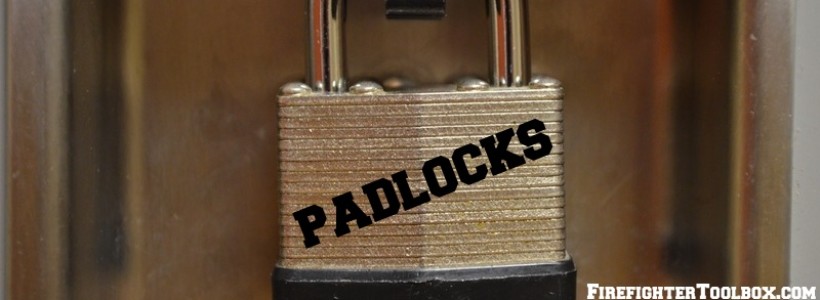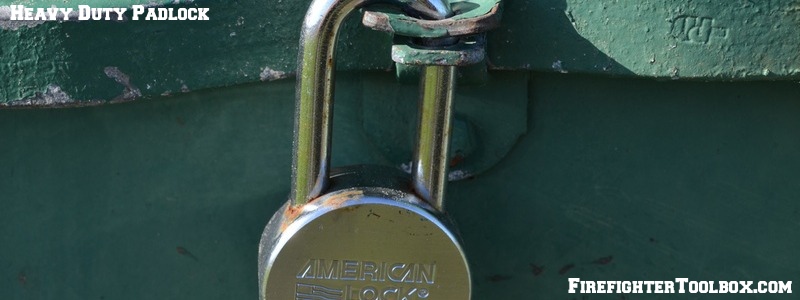How To Force Padlocks – Part 1
When we think forcible entry, we commonly think of inward or outward swinging doors that can be secured in a multitude of ways. However, there is much more to forcible entry than merely forcing a door with a set of irons. One of the other situations we will run into often is the use of padlocks.
Parts Of A Padlock
There are three parts commonly referred to when talking about padlocks. They are the shackle or sometimes called a bow, the actual body of the lock and the keyway (or dial in the case of a combination lock).
Two other terms that we should familiarize ourselves with is the toe and heel of the shackle. The toe is the part that actually comes out of the lock when it is in the open position and the heel is the part that actually stays in the lock. It should be noted that, on some locks, the toe and the heel may be lockable.

Types Of Padlocks
Padlocks are generally broken down into three main categories.
Light Duty locks are categorized by having a shackle with a diameter of a 1/4″ or less and is generally not case hardened. The body of the lock can be solid or laminated and more often than not does not have a guarded keyway. It can be a typical combination lock. You’ve seen these locks a thousand times. Anytime you have seen a padlock and thought to yourself, “This lock is a joke!” you have probably encountered a light duty padlock.
Heavy Duty locks have a shackle or bow with a diameter of 1/4″ or more. The body of the lock will be solid or laminated, and the lock may be constructed of case hardened steel. The keyway may also be guarded. These locks may also have a shackle that locks on both the toe and the heel side.
Special Duty locks have no exposed shackle. The locking device of this lock actually fits over the shackle. It is considered the toughest of the padlocks to force and is commonly referred to as a “hockey puck lock” or “donut lock.” The American 2000 Series is a very popular form of this lock that you will run into often.
Associated Hardware
Padlocks may be used alone, but in many instances we seem them associated with different types of hardware. Two of the most common we run into are hasps and slide bolts.
Hasps: Common with homeowners, they come in all shapes, sizes and strengths. Frequently mounted with screws, or in some instances carriage bolts, these are usually extremely easy to defeat. Usually the lock is actually stronger than the hasp that it is attached to.
Slide Bolts: This is a device that slides in a track into a hole mounted in the door frame. The lock goes into the end of the device prohibiting the slide from coming out of the frame. A slide bolt can be constructed of case hardened steel; they are frequently mounted with screws or carriage bolts as well. Depending on the type of slide bolt you encounter, the screw or bolt heads may be guarded.
Sizing Up The Padlock
As we should be doing on every aspect of fireground operations, the proper size up of a lock and any device associated with it is critical to our success. Some of the things we need to look for while sizing up our lock include:
- What size is the shackle – light duty or heavy duty?
- What does the body of the lock look like?
- What is holding the lock up? / What hardware is attached to the lock?
- Is the shackle guarded?
- Is the lock easily accessible?
- Are there multiple locks that need to be forced?
- Where is the lock?
If the lock is inside a structure, tool choice become important. Do you have the proper tool with you or will you have to attack the lock with what you have?
Keep in mind we want to go after the weakest part of the puzzle. If that is the lock itself, fine, attack it. But you may find that the hasp is held in by tiny little sheet metal screws. If that’s the case, ignore the lock and attack the hasp. Remember: Sometimes going after the hardware holding the lock is the easiest way to defeat it.
In part 2, we will talk about forcing padlocks with a variety of tools.
If you have any additional information on padlocks, please leave a comment in the comments section!
Photos courtesy of Rob Fling.
Check out the complete series here:
How To Force Padlocks – Part 1 (basics)
How To Force Padlocks – Part 2 (techniques) (posting next week)




